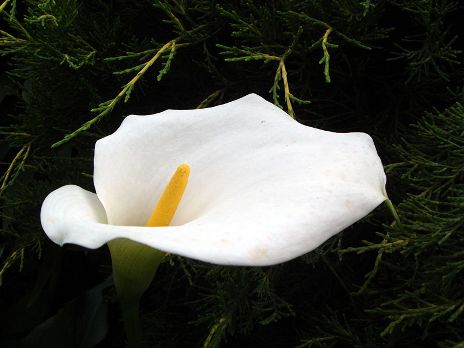Welcome!
Zantedeshica aethiopica, commonly referred to as the "Calla Lily"
or the "arum lily" is the beautiful flower that many associate with
weddings and funerals. While it can be found in numerous places
around the United States, it is not native to the states and is
considered an invasive species. Zantedeschia aethiopica originated
in South Africa, but has now been naturalized in many other
countries throughout the world. You can discover more about this
species' background and habitat on this page.
These elegant flowers are characterized by their long white plumes
encase a a barb-like structure known as a spadix. While their common
name suggests that they are a type of lily, they do not reside with
true lilies. A close relative of Z. aethiopica is the Skunk Cabbage
(Symplocarpus foetidus)
which also thrives in the same habitat. More evidence regarding the
phylogeny of the Zantedeschia aethiopica can be found on the
classification page.
While Z. aethiopica appears as an untainted, majestic flower, it is
poisonous and can cause harm to the health of any individual who
ingests the plant. All parts of the plant contain calcium oxalate
crystals known as raphides which can cause mild to severe symptoms.
More on the symptoms and ways to treat them can be found under
poison.
As stated earlier, Zantedeschia aethiopica is often an extremely
popular flower in weddings and in funerals. It is a very pure, and
stunning flower which has historically been associated with
celebratory gatherings. Its long history of being a highly-desirable
flower can be traced from as far back as ancient Rome!
Go ahead and explore the Calla Lily by clicking on any of the tabs
located at the top of the website.

